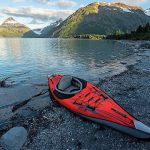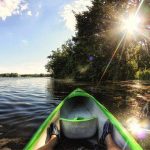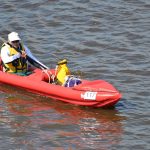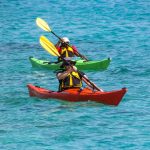A touring kayak is designed to move efficiently and comfortably over medium to long distances in open water. A kayak designed for open water paddling on lakes, bays, and the ocean is called a sea kayak or touring kayak.
These kayaks are small and sturdy with a covered deck and the ability to attach a spray deck. They are not as maneuverable as whitewater kayaks, but they are faster and can carry more cargo, making them better for long journeys.
Sea kayaks are used for marine journeys around the world that can last from a few hours to many weeks. They can hold one to three people as well as camping gear, food, water, and other supplies.
A solo sea kayak is usually 10-18 feet long and a tandem kayak is usually 26 feet long. The width of the kayak can be as little as 21 inches and as much as 36 inches.
The term “sea kayak” is said to have come from a book that was published in 1981. The book was called “sea kayak” and it was written by John Dowd. In the book, John Dowd said that before his book came out, people just called it “kayak touring” or “sea canoeing.”
But after his book came out, it started being called “sea kayaking.”
Design
The main difference between rigid kayaks and folding kayaks is that folding kayaks can be easily disassembled and packed for transport. Folding kayaks are also similar in design to skin-on-frame kayaks used by native people.
In addition, many folding kayaks include inflatable sponsons that improve the secondary stability of the vessel, helping to prevent capsize.
In recent years, there has been an increase in the production of sit-on-top kayaks. These kayaks are designed to be used on the sea, and are becoming increasingly popular.
Some innovative recent designs in rigid sea kayaks include eliminating the need for an internal frame by using stronger modern materials such as fiberglass, rotomolded plastic, and carbon fiber, which also significantly increases the weight.
Another design innovation is using nylon skins to create skin-on-frame sea kayaks, which are much lighter than the rigid sea kayaks.
- Recreational kayaks — shorter kayaks with wide beams and large cockpits intended for sheltered waters
- Sit-on-top kayaks — boats without an enclosed cockpit, but with the basic hull shape of a kayak.
- Inflatable kayaks with either a removable bladder within a tough outer skin or a single skin similar to that used in rigid inflatable boat (RIB) construction.
Size
Most kayaks have closed decks, although sit-on-top and inflatable kayaks are growing in popularity as well as pedal-powered and fishing kayaks. There are different types of kayaks that are designed for different purposes.
The size of the kayak is one factor that affects what it can be used for. The length of the kayak affects its cargo capacity and how well it tracks. The width of the kayak affects the cargo capacity and the size of the cockpit.
Most kayaks have a closed deck, but there are some that are open.
Material
A sea kayak constructed from plywood, epoxy, and fiberglass
The vast majority of rigid production kayaks are now made out of one of five materials: fiberglass, rotomolded polyethylene, thermoformed plastic, blow-molded polyethylene, or carbon-kevlar. Some less common materials include carbon fiber and foam core.
There are also a small number of kayaks that are hand-built from plywood or wood strips covered with fiberglass. Lastly, skin-on-frame kayaks are built on wood or aluminum frames covered in canvas, dacron, or other fabrics, and may include inflatable tubes called sponsons.
Some kayaks are made out of marine-grade plywood because it is lightweight but strong. Inflatable kayaks are either made out of PVC or more expensive single-skin designs made out of hypalon. PVC is cheaper but nylon is more resistant to abrasion.
Hypalon is tough and easy to dry after use.
Equipment
It is also one of the few places in the world where you can see dolphins in their natural habitat. Sea kayaking is a popular activity for exploring Kealakekua Bay, Hawaii. The bay is also one of the few places in the world where you can see dolphins in their natural habitat.
Most sea kayaks have a rudder, operated by the feet through foot pedals, which helps with steering and with keeping the boat on a straight course. There are many different designs of sea kayaks, which allows them to be used for different purposes.
Some kayaks are shorter and more maneuverable while others are longer and travel faster in a straight line. The width of the kayak can also affect its stability and speed.
Most sea kayaks have a rudder, which is a small paddle that is controlled by the feet, to help with steering and keeping the kayak going straight.
Most kayaks have either rudders or skegs to help with steering or tracking. Rudders are usually attached to the back of the kayak and are controlled by foot pedals in the cockpit, while skegs are straight blades that come down from the back of the kayak.
Both help when paddling in windy or wavy conditions. Some skegs may be more effective than others in countering pitch, roll, and yaw.
Best ocean kayaks in 2023
Delta Kayaks Delta 17
The Delta Kayaks Delta 17 is a long, narrow, and streamlined design that gives it a sharp profile as it cruises across the waves. At 17 feet long and less than two-feet wide, the Delta is an efficient craft boasting an impressive top speed and solid tracking that’s perfect for long paddle days.
It works well as an expedition kayak, being able to go on week-long trips if you pack lightly. The standard, watertight bow and stern hatches have a large load capacity of 410 pounds, which should accommodate most paddle trips.
You can also store things on deck, with bungee cords in front of, and behind the cockpit.
The Delta has a rudder to make it easier to steer, which can come in handy when paddling in crosswinds.
There’s no reason to put up with an uncomfortable kayak seat when there are great options like the Delta 17 available. This kayak’s seat can be easily adjusted forward and back to get the perfect fit, and it coordinates well with the foot pedals.
Plus, the seat is well-padded for extra comfort and has great back support, even for tall paddlers.
The Delta 17 canoe is surprisingly lightweight at 50 pounds, and includes T-handle carriers to make tandem portages easy.
Boreal Baffin P3
The Boreal Baffin P3 is one of the longest canoes on the market, at 17 feet 7 inches. Its large size gives it a lot of storage space, including a small third hatch in the cockpit that can be accessed from the canoe. I would prefer the bow hatch to be a little larger, so plan on putting your larger gear in the stern.
The keel on the Boreal is a little wider than the Delta 17, but it’s longer, so it goes just as fast. Instead of having a rudder, it has a skeg, which is a fin that comes down from the back of the boat. You can pull the skeg up when you’re going into shallow water.
It’s not as good for steering as a rudder, but it keeps the boat going straight in rough, windy weather.
I believe that if you want a boat of this size, you’re looking for one that can hold more weight for longer trips. The load capacity of 348 pounds is good, but if you’re planning on taking longer trips (more than three or four days), you may want to choose the Delta 17.
You can use the Baffin for extended expeditions, but be careful not to overload it or it will become unstable.
To ensure comfort while paddling, the Baffin’s seat is made from a quick-drying fabric that can be adjusted to the paddler’s preference. The foot pedals and thigh braces are also adjustable, making the Baffin a good option for most people.
It is slightly wider than average, which may make it more comfortable for larger or taller paddlers.
Riot Edge 14.5
The Riot Edge 14.5 is a smaller and simpler ocean kayak that serves as a cheaper entry point to the world of kayaking.
The addition of a rudder makes maneuvering and tracking easier for newcomers, which also gives you the confidence to head out into water that you may be hesitant to explore without one.
The seat on this kayak is well-padded, making it comfortable for long days on the water. However, you’ll need to adjust the straps on the seatback before you launch.
Once on the water, they’re too cumbersome to adjust without the risk of capsizing.
The Riot Edge is best used as a day or weekend boat because it is shorter and has a low load capacity. The shorter keel means that there is less watertight storage space. However, it still has the two watertight hatches and bungee rigging on deck.
The Riot Edge is two-and-a-half feet shorter than the Delta 17, but they are still virtually the same width. As a result, the Riot Edge won’t be as fast as its longer cousins.
Newcomers and budget-conscious paddlers will love the Riot’s versatility and impressive maneuverability.
Wilderness Systems Tsunami 145
The Wilderness Systems Tsunami 145 is a great choice for beginners. It comes with everything you need to get started.
The Tsunami 145 is our best pick for beginners thanks to its additional stability. Being three inches wider than the Riot Edge 14.5 makes the Tsunami 145 a reliable and comfortable paddle for those that may be a little nervous about setting out.
The kayak’s biggest drawback is that it is slower and more difficult to maneuver than the sleeker kayaks discussed above. A rudder is included, so steering is easy for newcomers.
However, the wider hull will make sharper turns and navigating tight areas more challenging.
The extra width of the cockpit provides more space and room to move around. You still get the two watertight hatches and a load capacity that is comparable to many other kayaks in this class. I would love to see a larger hatch in the bow.
But I really appreciate the two on-deck mesh storage bags that allow you to keep day gear close by.
Thigh braces, solid foot pedals, and another well-padded, adjustable seat provide excellent support and make for a relaxing day out on the water. If you’re just getting started and value stability over speed, look no further than the Tsunami 145 for your next (or first) weekend getaway.
This kayak is designed for beginners who want a stable and comfortable kayak that is still fun to paddle.
Delta Kayaks Delta Traverse 17.5T
Delta’s second kayak on our list is the Traverse 17.5T. It shares some similarities with the Delta 17, such as the sliding, adjustable seat that makes it easy to find the right sitting position.
The long waterline and included rudder provide good balance between maneuverability and speed. And since there are two paddlers, the wider hull doesn’t reduce the Traverse’s paddling efficiency.
The max capacity is two people, but it includes the weight of the paddlers. Most expeditions won’t have a problem with this. I also like the third hatch because it’s easy to access both on and off the water.
This kayak is large but only weighs 65 pounds because it is made out of ABS plastic. The handles on the bow and stern can be retracted, making it easy to carry despite its size.
The Traverse is able to maintain its course in all water conditions because the rudder system is both intuitive and responsive.
However, because the Traverse is a long and wide boat, traveling through narrower waterways can be more challenging.



